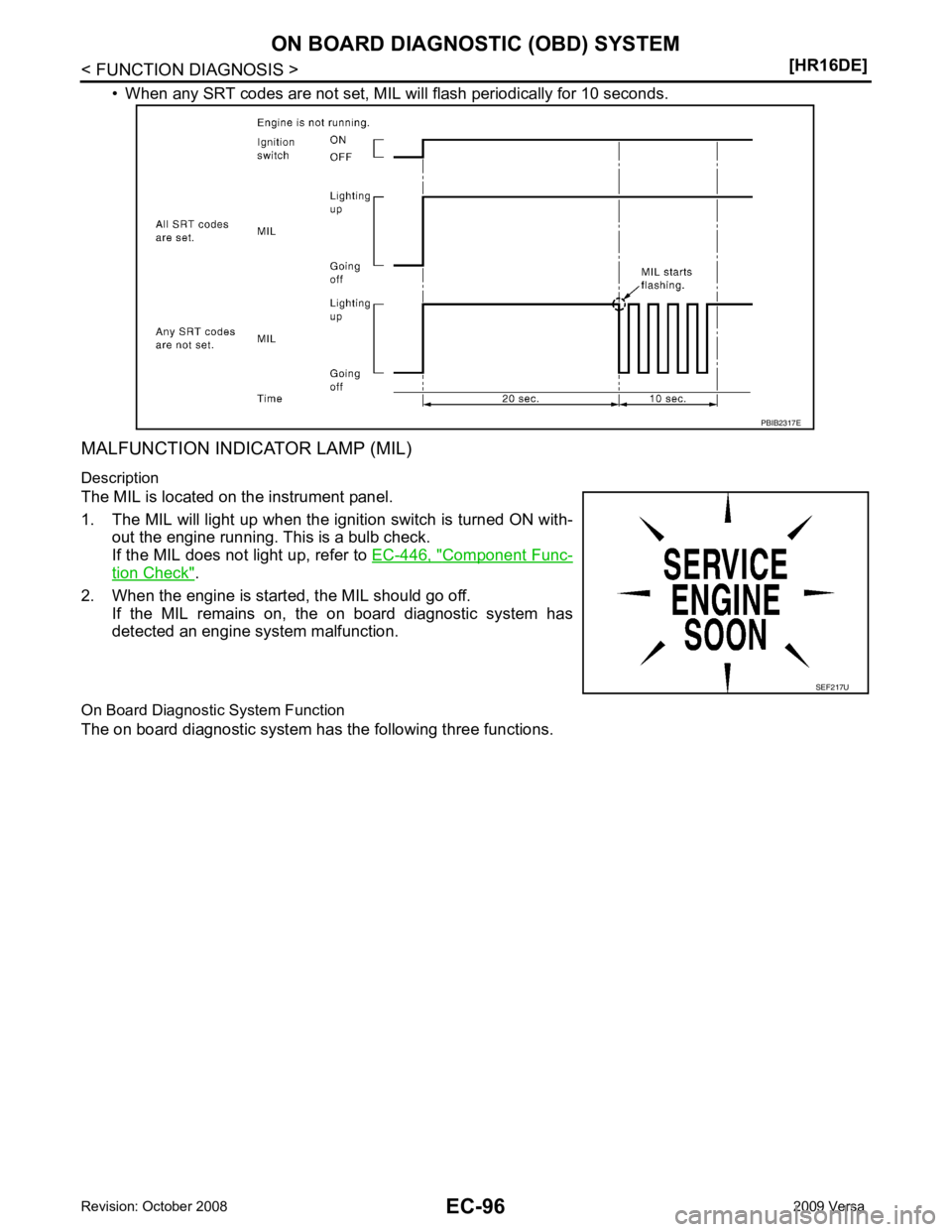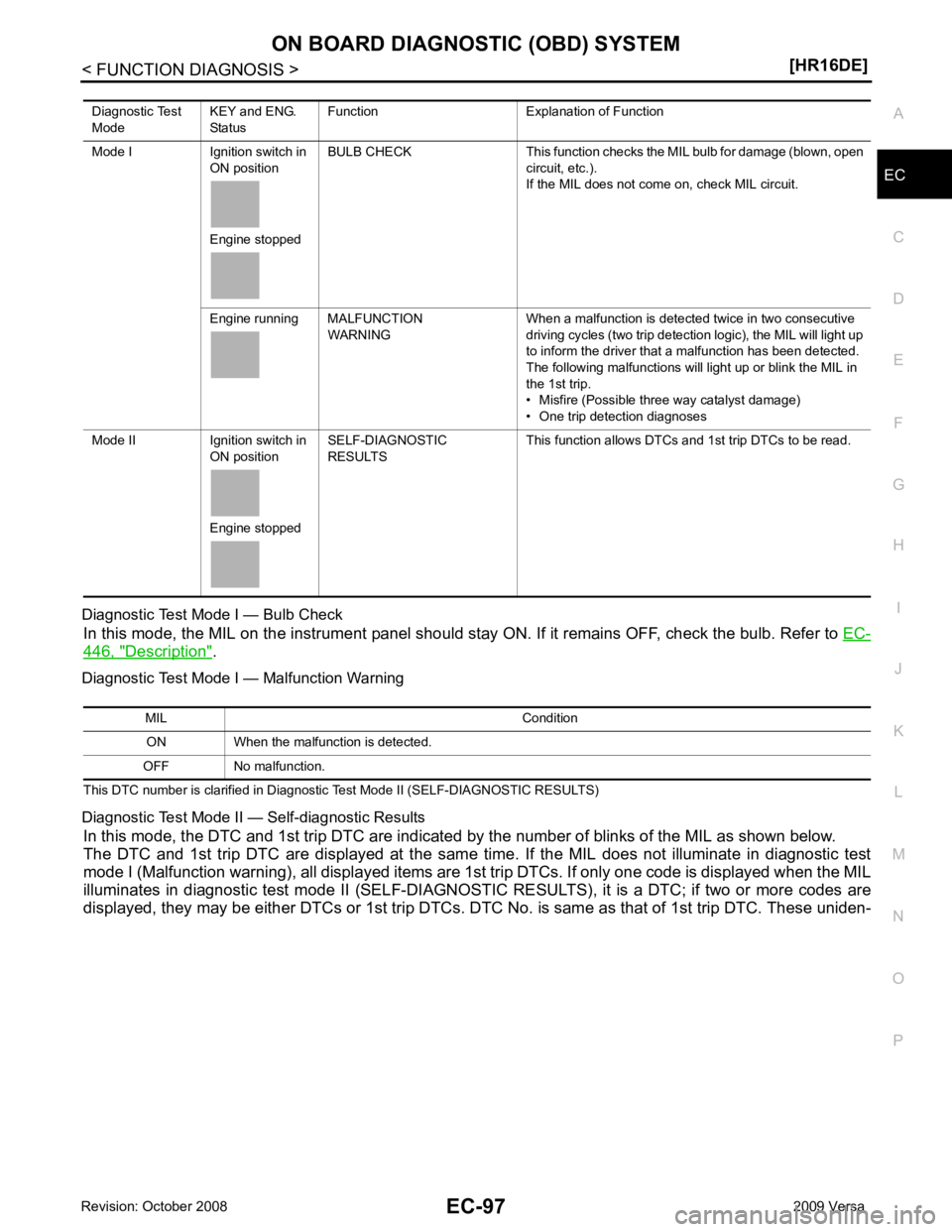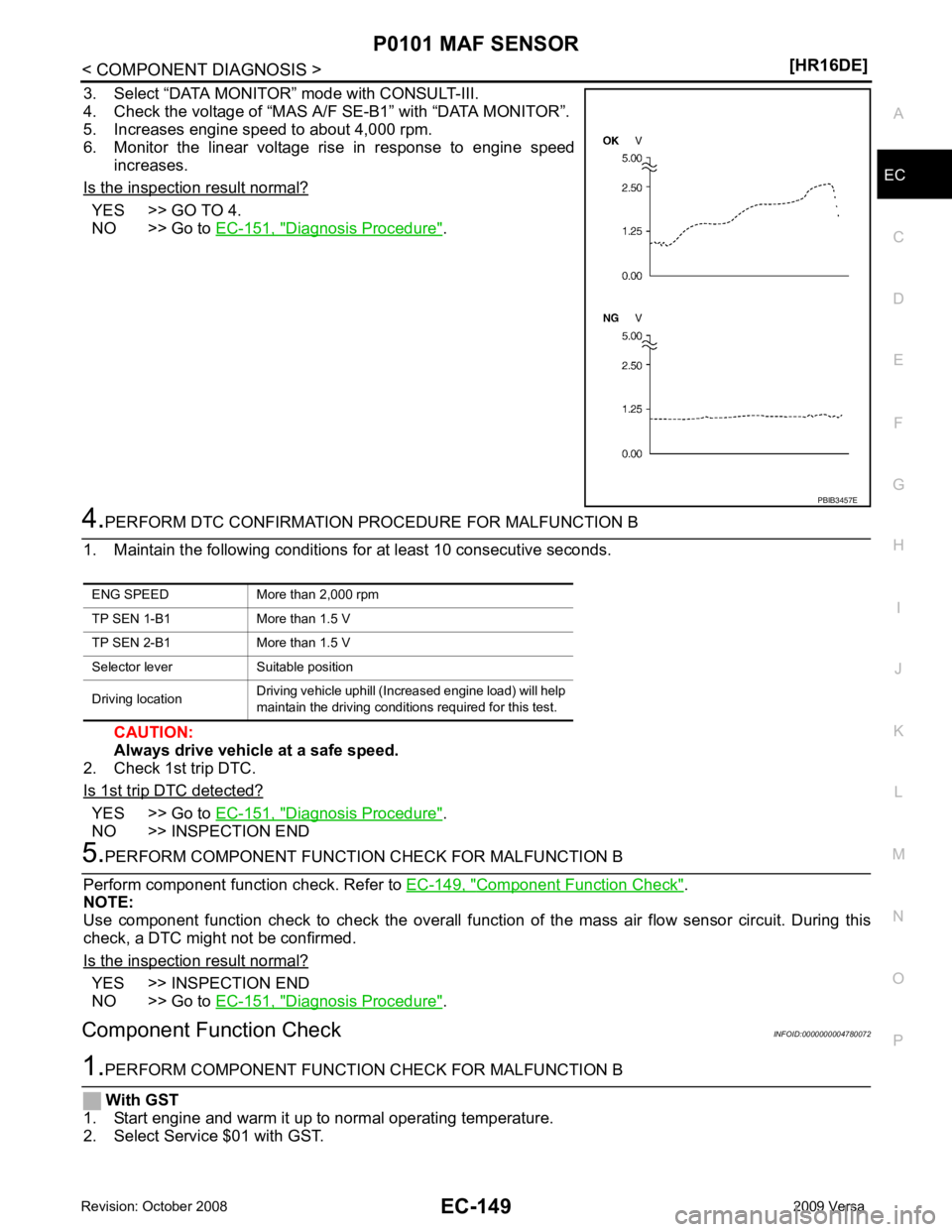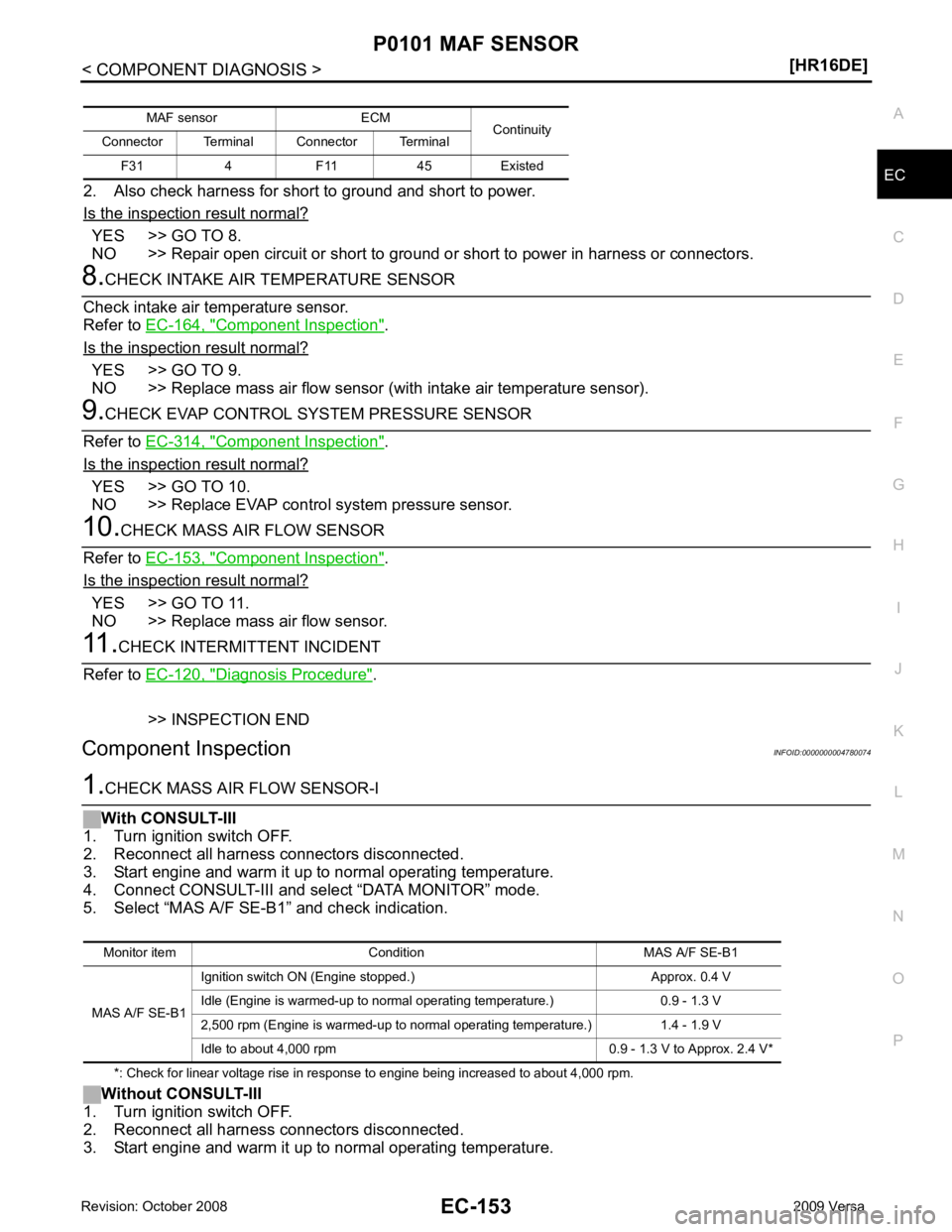2009 NISSAN LATIO check engine
[x] Cancel search: check enginePage 1452 of 4331

Component Func-
tion Check " .
2. When the engine is started, the MIL should go off. If the MIL remains on, the on board diagnostic system has
detected an engine system malfunction.
On Board Diagnostic System Function
The on board diagnostic system has the following three functions. SEF217U
Page 1453 of 4331

EC
NP
O
Diagnostic Test Mode I — Bulb Check
In this mode, the MIL on the instrument panel should st ay ON. If it remains OFF, check the bulb. Refer to EC-446, " Description " .
Diagnostic Test Mode I — Malfunction Warning
This DTC number is clarified in Diagnostic Test Mode II (SELF-DIAGNOSTIC RESULTS)
Diagnostic Test Mode II — Self-diagnostic Results In this mode, the DTC and 1st trip DTC are indicated by the number of blinks of the MIL as shown below.
The DTC and 1st trip DTC are displayed at the same time. If the MIL does not illuminate in diagnostic test
mode I (Malfunction warning), all displa yed items are 1st trip DTCs. If only one code is displayed when the MIL
illuminates in diagnostic test mode II (SELF-DIAGNOSTIC RESULTS), it is a DTC; if two or more codes are
displayed, they may be either DTCs or 1st trip DTCs. DTC No. is same as that of 1st trip DTC. These uniden-
Diagnostic Test
Mode KEY and ENG.
Status Function Explanation of Function
Mode I Ignition switch in ON position
Engine stopped BULB CHECK This function checks the MIL bulb for damage (blown, open
circuit, etc.).
If the MIL does not come on, check MIL circuit.
Engine running MALFUNCTION WARNING When a malfunction is detected twice in two consecutive
driving cycles (two trip detection logic), the MIL will light up
to inform the driver that a malfunction has been detected.
The following malfunctions will light up or blink the MIL in
the 1st trip.
• Misfire (Possible three way catalyst damage)
• One trip detection diagnoses
Mode II Ignition switch in ON position
Engine stopped SELF-DIAGNOSTIC
RESULTS This function allows DTCs and 1st trip DTCs to be read.
Page 1465 of 4331

EC
NP
O
Test Item
*: Leaving cooling fan OFF with CONSULT-III while engine is running may cause the engine to overheat.
DTC & SRT CONFIRMATION MODE
SRT STATUS Mode For details, refer to EC-90, " Diagnosis Description " .
SRT WORK SUPPORT Mode This mode enables a technician to drive a vehicle to set the SRT while monitoring the SRT status.
DTC WORK SUPPORT Mode TEST ITEM CONDITION JUDGMENT CHECK ITEM (REMEDY)
FUEL INJECTION • Engine: Return to the original
trouble condition
• Change the amount of fuel injec- tion using CONSULT-III. If trouble symptom disappears, see
CHECK ITEM. • Harness and connectors
• Fuel injector
• Air fuel ratio (A/F) sensor 1
IGNITION TIMING • Engine: Return to the original
trouble condition
• Timing light: Set
• Retard the ignition timing using
CONSULT-III. If trouble symptom disappears, see
CHECK ITEM. • Perform Idle Air Volume Learning.
POWER BALANCE • Engine: After warming up, idle
the engine.
• A/C switch OFF
• Selector lever: P or N position (A/ T), Neutral position (M/T)
• Cut off each fuel injector signal
one at a time using CONSULT-
III. Engine runs rough or dies.
• Harness and connectors
• Compression
• Fuel injector
• Power transistor
• Spark plug
• Ignition coil
COOLING FAN* • Ignition switch: ON
• Turn the cooling fan “LOW”, “HI”
and “OFF” using CONSULT-III. Cooling fan moves and stops.
• Harness and connectors
• IPDM E/R (Cooling fan relay)
• Cooling fan motor
ENG COOLANT
TEMP • Engine: Return to the original
trouble condition
• Change the engine coolant tem-
perature using CONSULT-III. If trouble symptom disappears, see
CHECK ITEM. • Harness and connectors
• Engine coolant temperature sen- sor
• Fuel injector
FUEL PUMP RELAY • Ignition switch: ON (Engine
stopped)
• Turn the fuel pump relay “ON”
and “OFF” using CONSULT-III
and listen to operating sound. Fuel pump relay makes the operat-
ing sound. • Harness and connectors
• Fuel pump relay
PURG VOL CONT/V • Engine: After warming up, run
engine at 1,500 rpm.
• Change the EVAP canister purge volume control solenoid
valve opening percent using
CONSULT-III. Engine speed changes according
to the opening percent. • Harness and connectors
• Solenoid valve
FUEL/T TEMP SEN • Change the fuel tank temperature using CONSULT-III.
VENT CONTROL/V • Ignition switch: ON (Engine
stopped)
• Turn solenoid valve “ON” and “OFF” using th e CONSULT-III
and listen to operating sound. Solenoid valve makes an operating
sound. • Harness and connectors
• Solenoid valve
V/T ASSIGN ANGLE • Engine: Return to the original
trouble condition
• Change intake valve timing us-
ing CONSULT-III. If trouble symptom disappears, see
CHECK ITEM. • Harness and connectors
• Intake valve timing control sole- noid valve
Page 1505 of 4331

EC
NP
O
3. Select “DATA MONITOR” mode with CONSULT-III.
4. Check the voltage of “MAS A/F SE-B1” with “DATA MONITOR”.
5. Increases engine speed to about 4,000 rpm.
6. Monitor the linear voltage rise in response to engine speed
increases.
Is the inspection result normal? YES >> GO TO 4.
NO >> Go to EC-151, " Diagnosis Procedure " .
YES >> Go to
EC-151, " Diagnosis Procedure " .
NO >> INSPECTION END Component Function Check " .
NOTE:
Use component function check to check the overall function of the mass air flow sensor circuit. During this
check, a DTC might not be confirmed.
Is the inspection result normal? YES >> INSPECTION END
NO >> Go to EC-151, " Diagnosis Procedure " .
Component Function Check INFOID:0000000004780072
Page 1509 of 4331

EC
NP
O
2. Also check harness for short to ground and short to power.
Is the inspection result normal? YES >> GO TO 8.
NO >> Repair open circuit or short to ground or short to power in harness or connectors. Component Inspection " .
Is the inspection result normal? YES >> GO TO 9.
NO >> Replace mass air flow sensor ( with intake air temperature sensor).Component Inspection " .
Is the inspection result normal? YES >> GO TO 10.
NO >> Replace EVAP control system pressure sensor. Component Inspection " .
Is the inspection result normal? YES >> GO TO 11.
NO >> Replace mass air flow sensor. Diagnosis Procedure " .
>> INSPECTION END
Component Inspection INFOID:0000000004780074Monitor item Condition MAS A/F SE-B1
MAS A/F SE-B1 Ignition switch ON (Engine stopped.) Approx. 0.4 V
Idle (Engine is warmed-up to normal operating temperature.) 0.9 - 1.3 V
2,500 rpm (Engine is warmed-up to normal operating temperature.) 1.4 - 1.9 V
Idle to about 4,000 rpm 0.9 - 1.3 V to Approx. 2.4 V*
Page 1511 of 4331
![NISSAN LATIO 2009 Service Repair Manual P0101 MAF SENSOR
EC-155
< COMPONENT DIAGNOSIS >
[HR16DE] C
D E
F
G H
I
J
K L
M A EC
NP
O
3. Check the voltage between ECM harness connector and
ground.
*: Check for linear voltage rise in respo NISSAN LATIO 2009 Service Repair Manual P0101 MAF SENSOR
EC-155
< COMPONENT DIAGNOSIS >
[HR16DE] C
D E
F
G H
I
J
K L
M A EC
NP
O
3. Check the voltage between ECM harness connector and
ground.
*: Check for linear voltage rise in respo](/manual-img/5/57359/w960_57359-1510.png)
P0101 MAF SENSOR
EC-155
< COMPONENT DIAGNOSIS >
[HR16DE] C
D E
F
G H
I
J
K L
M A EC
NP
O
3. Check the voltage between ECM harness connector and
ground.
*: Check for linear voltage rise in response to engine being increased to about 4,000 rpm.
Is the inspection result normal? YES >> INSPECTION END
NO >> GO TO 4. 4.
CHECK MASS AIR FLOW SENSOR-III
With CONSULT-III
1. Turn ignition switch OFF.
2. Disconnect mass air flow sensor har ness connector and reconnect it again.
3. Start engine and warm it up to normal operating temperature.
4. Connect CONSULT-III and select “DATA MONITOR” mode.
5. Select “MAS A/F SE-B1” and check indication.
*: Check for linear voltage rise in response to engine being increased to about 4,000 rpm.
Without CONSULT-III
1. Turn ignition switch OFF.
2. Disconnect mass air flow sensor har ness connector and reconnect it again.
3. Start engine and warm it up to normal operating temperature.
4. Check the voltage between ECM harness connector and ground.
*: Check for linear voltage rise in response to engine being increased to about 4,000 rpm.
Is the inspection result normal? YES >> INSPECTION END
NO >> Clean or replace mass air flow sensor. ECM
Ground Condition Voltage
Con-
nector Termi-
nal
F11 45
(MAF
sensor
signal) Ground Ignition switch ON (Engine stopped.) Approx. 0.4 V
Idle (Engine is wa rmed-up to normal
operating temperature.) 0.9 - 1.3 V
2,500 rpm (Engine is warmed-up to
normal operating temperature.) 1.4 - 1.9 V
Idle to about 4,000 rpm 0.9 - 1.3 V to
Approx. 2.4 V* PBIA9564J
Monitor item Condition MAS A/F SE-B1
MAS A/F SE-B1 Ignition switch ON (Engine stopped.) Approx. 0.4 V
Idle (Engine is warmed-up to normal operating temperature.) 0.9 - 1.3 V
2,500 rpm (Engine is warmed-up to normal operating temperature.) 1.4 - 1.9 V
Idle to about 4,000 rpm 0.9 - 1.3 V to Approx. 2.4 V*
ECM Ground Condition Voltage
Con-
nector Termi-
nal
F11 45
(MAF
sensor
signal) Ground Ignition switch ON (Engine stopped.) Approx. 0.4 V
Idle (Engine is wa rmed-up to normal
operating temperature.) 0.9 - 1.3 V
2,500 rpm (Engine is warmed-up to
normal operating temperature.) 1.4 - 1.9 V
Idle to about 4,000 rpm 0.9 - 1.3 V to
Approx. 2.4 V* PBIA9564J
Page 1512 of 4331
![NISSAN LATIO 2009 Service Repair Manual EC-156< COMPONENT DIAGNOSIS >
[HR16DE]
P0102, P0103 MAF SENSOR
P0102, P0103 MAF SENSOR
Description INFOID:0000000004780075
The mass air flow sensor (1) is placed in the stream of intake a NISSAN LATIO 2009 Service Repair Manual EC-156< COMPONENT DIAGNOSIS >
[HR16DE]
P0102, P0103 MAF SENSOR
P0102, P0103 MAF SENSOR
Description INFOID:0000000004780075
The mass air flow sensor (1) is placed in the stream of intake a](/manual-img/5/57359/w960_57359-1511.png)
EC-156< COMPONENT DIAGNOSIS >
[HR16DE]
P0102, P0103 MAF SENSOR
P0102, P0103 MAF SENSOR
Description INFOID:0000000004780075
The mass air flow sensor (1) is placed in the stream of intake air. It
measures the intake flow rate by measuring a part of the entire
intake flow. The mass air flow sensor controls the temperature of the
hot wire to a certain amount. The heat generated by the hot wire is
reduced as the intake air flows around it. The more air, the greater
the heat loss.
Therefore, the electric current supplied to hot wire is changed to
maintain the temperature of the hot wire as air flow increases. The
ECM detects the air flow by means of this current change.
DTC Logic INFOID:0000000004780076
DTC DETECTION LOGIC
DTC CONFIRMATION PROCEDURE 1.
PRECONDITIONING
If DTC Confirmation Procedure has been previously conduc ted, always turn ignition switch OFF and wait at
least 10 seconds before conducting the next test.
Which DTC is detected? P0102 >> GO TO 2.
P0103 >> GO TO 3. 2.
PERFORM DTC CONFIRMATION PROCEDURE FOR DTC P0102
1. Start engine and wait at least 5 seconds.
2. Check DTC.
Is DTC detected? YES >> Go to
EC-157, " Diagnosis Procedure " .
NO >> INSPECTION END 3.
PERFORM DTC CONFIRMATION PROCEDURE FOR DTC P0103-I
1. Turn ignition switch ON and wait at least 5 seconds.
2. Check DTC.
Is DTC detected? YES >> Go to
EC-157, " Diagnosis Procedure " .
NO >> GO TO 4. 4.
PERFORM DTC CONFIRMATION PROCEDURE FOR DTC P0103-II
1. Start engine and wait at least 5 seconds.
2. Check DTC.
Is DTC detected? YES >> Go to
EC-157, " Diagnosis Procedure " .
NO >> INSPECTION END PBIA9559J
DTC No. Trouble diagnosis name DTC detecting condition Possible cause
P0102 Mass air flow sensor circuit
low input An excessively low voltage from the sensor is
sent to ECM. • Harness or connectors
(The sensor circuit is open or shorted.)
• Intake air leaks
• Mass air flow sensor
P0103 Mass air flow sensor circuit
high input An excessively high voltage from the sensor is
sent to ECM. • Harness or connectors
(The sensor circuit is open or shorted.)
• Mass air flow sensor
Page 1515 of 4331
![NISSAN LATIO 2009 Service Repair Manual P0102, P0103 MAF SENSOR
EC-159
< COMPONENT DIAGNOSIS >
[HR16DE] C
D E
F
G H
I
J
K L
M A EC
NP
O
2. Also check harness for short to ground and short to power.
Is the inspection result normal? YES >> GO NISSAN LATIO 2009 Service Repair Manual P0102, P0103 MAF SENSOR
EC-159
< COMPONENT DIAGNOSIS >
[HR16DE] C
D E
F
G H
I
J
K L
M A EC
NP
O
2. Also check harness for short to ground and short to power.
Is the inspection result normal? YES >> GO](/manual-img/5/57359/w960_57359-1514.png)
P0102, P0103 MAF SENSOR
EC-159
< COMPONENT DIAGNOSIS >
[HR16DE] C
D E
F
G H
I
J
K L
M A EC
NP
O
2. Also check harness for short to ground and short to power.
Is the inspection result normal? YES >> GO TO 8.
NO >> Repair open circuit or short to ground or short to power in harness or connectors. 8.
CHECK MASS AIR FLOW SENSOR
Refer to EC-159, " Component Inspection " .
Is the inspection result normal? YES >> GO TO 9.
NO >> Replace mass air flow sensor. 9.
CHECK INTERMITTENT INCIDENT
Refer to EC-120, " Diagnosis Procedure " .
>> INSPECTION END
Component Inspection INFOID:00000000047800781.
CHECK MASS AIR FLOW SENSOR-I
With CONSULT-III
1. Turn ignition switch OFF.
2. Reconnect all harness connectors disconnected.
3. Start engine and warm it up to normal operating temperature.
4. Connect CONSULT-III and select “DATA MONITOR” mode.
5. Select “MAS A/F SE-B1” and check indication.
*: Check for linear voltage rise in response to engine being increased to about 4,000 rpm.
Without CONSULT-III
1. Turn ignition switch OFF.
2. Reconnect all harness connectors disconnected.
3. Start engine and warm it up to normal operating temperature.
4. Check the voltage between ECM harness connector and ground. MAF sensor ECM
Continuity
Connector Terminal Connector Terminal
F31 4 F11 45 Existed Monitor item Condition MAS A/F SE-B1
MAS A/F SE-B1 Ignition switch ON (Engine stopped.) Approx. 0.4 V
Idle (Engine is warmed-up to normal operating temperature.) 0.9 - 1.3 V
2,500 rpm (Engine is warmed-up to normal operating temperature.) 1.4 - 1.9 V
Idle to about 4,000 rpm 0.9 - 1.3 V to Approx. 2.4 V*
ECM Ground Condition Voltage
Con-
nector Termi-
nal
F11 45
(MAF
sensor signal) Ground Ignition switch ON (Engine stopped.) Approx. 0.4 V
Idle (Engine is wa rmed-up to normal
operating temperature.) 0.9 - 1.3 V
2,500 rpm (Engine is warmed-up to
normal operating temperature.) 1.4 - 1.9 V
Idle to about 4,000 rpm 0.9 - 1.3 V to
Approx. 2.4 V* PBIA9564J